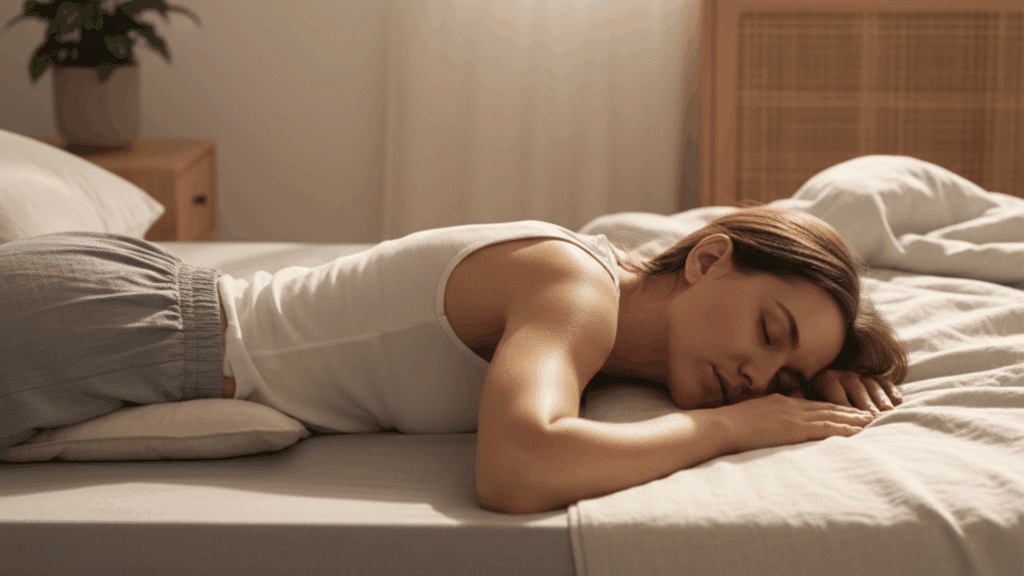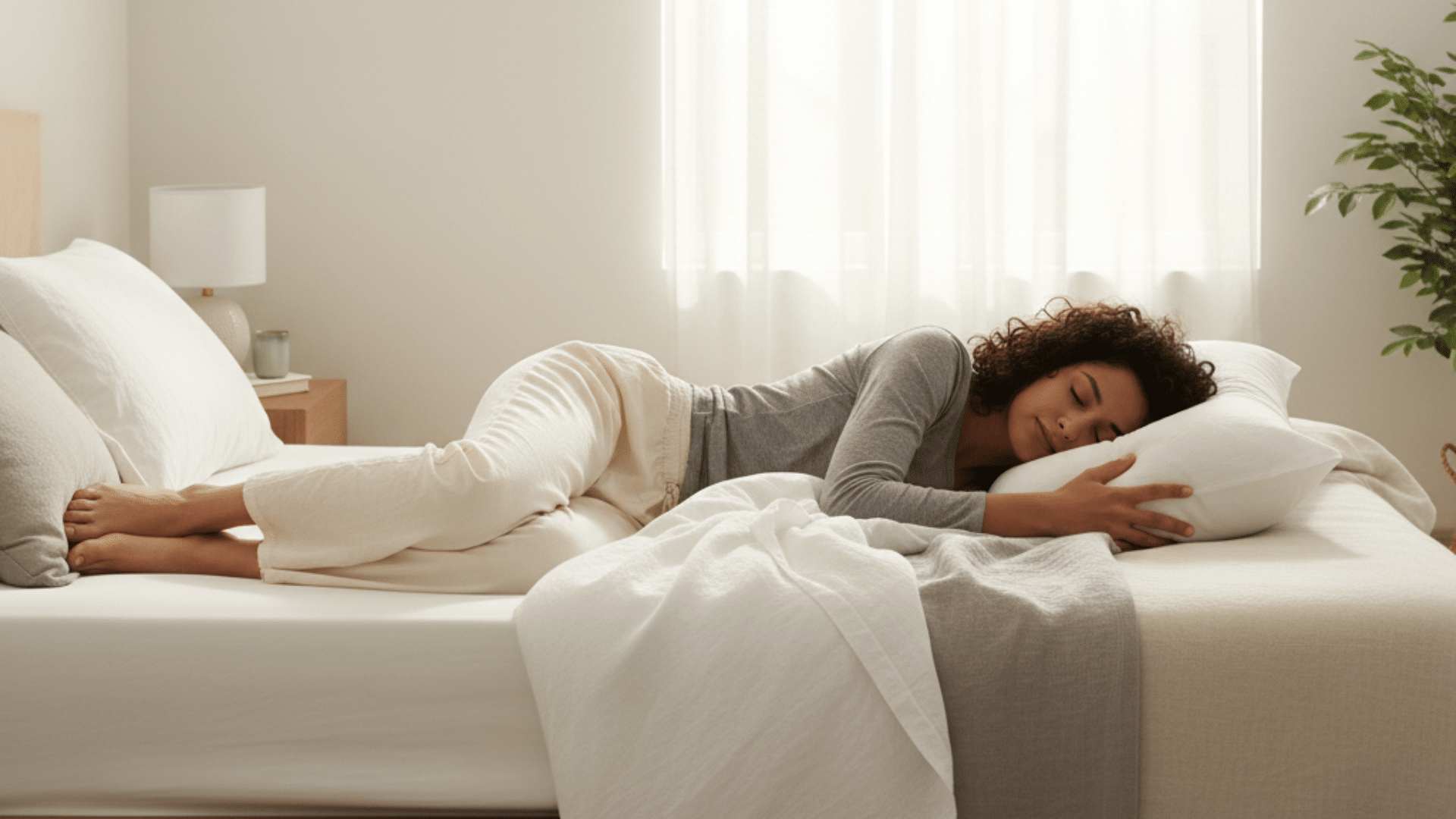I remember the first time I woke up with a stiff neck and thought something serious was wrong. It took me a while to realize the problem wasn’t my mattress or the way I moved at night; it was my pillow.
You’ve probably felt the same at some point, wondering why your neck feels tight even after a full night of rest. That’s why getting the correct pillow position for better sleeping posture matters so much.
It’s one of the simplest ways to protect your neck and help your body stay relaxed through the night.
I’ll walk you through the small changes that make the biggest difference, so you can settle in with a setup that feels steady and supportive.
Best Sleeping Positions For Good Posture
The way you position your body at night affects how your neck and back feel in the morning. Good posture in sleep keeps your spine straight, reduces pressure on your joints, and helps your muscles relax.
Side sleeping is the best overall position because it supports your spine when you use a firm pillow and a knee pillow.
Back sleeping also works well, especially when you place a pillow under your knees to ease lower-back strain.
Stomach sleeping is the least helpful, but you can make it safer with a thin pillow or no pillow. Choosing the right sleeping position sets the foundation for steady support and better rest.
Correct Pillow Position For Each Sleep Type
Set up your pillow based on how you sleep so your neck stays supported and your body stays in a natural, steady line.
Back Sleeper Setup

When you sleep on your back, place your pillow under your head and neck only. Your shoulders should stay on the mattress so your neck sits in a natural curve.
Your pillow should keep your chin level and your head centered without lifting it too high. If your lower back feels tight, add a small pillow under your knees to reduce pressure.
Keep your arms in a relaxed position on either side of your body. This setup supports your spine and helps you wake up with less tightness and strain.
Side Sleeper Setup

When you sleep on your side, your pillow should fill the space between your ear and the mattress so your head stays level.
Keep your bottom shoulder on the mattress, not on the pillow, so your neck doesn’t bend. Add a pillow between your knees to keep your hips stacked and reduce twisting in your lower back.
Hug a soft pillow to stop your top shoulder from rolling forward. This setup keeps your body straight from head to hips and helps reduce morning soreness in your neck and shoulders.
Stomach Sleeper Setup

If you sleep on your stomach, use a thin pillow or no pillow so your neck doesn’t twist too far. Keep your head turned as little as possible and try to keep your shoulders even.
You can place a small pillow under your chest or hips to reduce pressure in your lower back.
Keep your arms in a comfortable spot so your shoulders don’t feel pulled. This setup lowers strain on your neck and spine and helps you avoid stiffness when you wake up.
Signs You Picked The Wrong Pillow
You may need a new pillow if you notice:
- Morning headaches
- A chin tilt toward your chest
- Numb fingers or tingling hands
- Your ear is not lining up with your shoulder when side sleeping
- Stiffness in your neck or upper back
These signs show your pillow height or firmness is off.
Quick Tests To Check Your Alignment
You can check your sleep posture in less than a minute. These simple tests show if your pillow height and support are working for your neck and spine.
The goal is to make sure your body stays in a straight, steady line from head to hips. When these points don’t match, your pillow setup needs adjustment.
Wall-to-Bed Test: Stand with your back against a wall and keep your head in line with your spine. Then lie down in your usual sleep position. If your head tilts higher or lower than it did while standing, your pillow height is off and needs to be raised or lowered.
30-Second Alignment Check: Look for three quick signs: your ear should sit above your shoulder, your chin should point forward instead of downward, and your hips should stay level without twisting.
If anything feels uneven, adjust your pillow height or firmness until your body feels balanced.
Shoulder Placement Explained
Your shoulders should always rest on the mattress, not on the pillow. Only your head and neck need support from the pillow.
When your shoulder sits on the pillow, your neck bends at an angle that strains your spine. This can lead to stiffness, numb arms, and morning discomfort.
Keeping your shoulder on the mattress lets your head and neck stay in a straight, natural line. This also gives your upper back more room to relax.
If your pillow feels too high or pushes your shoulder up, lower the height or choose a softer option for better alignment.
Final Thoughts
I covered how your sleep position, pillow height, and simple alignment checks can make your nights feel easier and your mornings more comfortable.
When you focus on steady neck support and the right pillow setup, you give your body a better chance to rest without strain.
Keeping the correct pillow position in mind to improve your sleeping posture can help you avoid the tightness and pressure that build up over time.
I hope you try a few of these small adjustments tonight and see how your body responds.
If you want more simple and helpful tips, keep checking the other guides I’ve shared. Your comfort matters, and I’m here to help you keep improving it.









